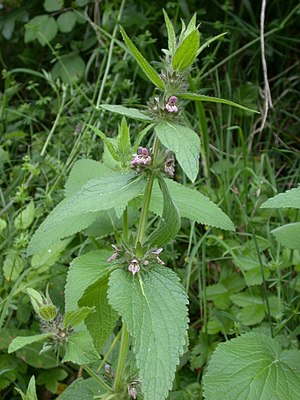Alpen-Ziest
| Alpen-Ziest | ||||||||||||
|---|---|---|---|---|---|---|---|---|---|---|---|---|

Alpine ziest ( Stachys alpina ) |
||||||||||||
| Systematics | ||||||||||||
|
||||||||||||
| Scientific name | ||||||||||||
| Stachys alpina | ||||||||||||
| L. |
The alpine Ziest ( Stachys alpina ) is a plant from the genus of Stachys ( Stachys ) in the family of Labiatae (Lamiaceae).
description
The Alpen-Ziest grows as a deciduous, perennial herbaceous plant that reaches heights of 30 to 100 cm. It forms a creeping rhizome as a permanent organ. The upright or ascending, square, strong, cloudy green and often purple stalk is about 5 mm thick at the base, hairy protruding and hairy in the upper area with glandular hair.
The constantly against arranged on the stem leaves are divided into petiole and leaf blade. The petiole is 1 to 5 cm long. The relatively thin leaf blade, dark green on top, is 5 to 18 cm long and 3 to 9 cm wide, oblong-egg-shaped, rounded at the base or slightly heart-shaped, gray or gray-green, strongly veined and dense on both sides, close-fitting , short haired. The leaf margin is finely to roughly serrated.
The inflorescence consists of 6 to 18 superimposed and at least half the bract length separated pseudo whorls, which contain 12 to 20 flowers and are all dominated by the bracts. The hermaphrodite, zygomorphic flower is 15 to 18 mm long and has a double flower envelope . The green or purple-brown and densely glandular-shaggy hairy, 6 to 12 mm long sepals are fused into an approximately 6 mm long calyx tube. The 15 to 22 mm long, dark purple to brown purple and long shaggy haired corolla is two-lipped. Her upper lip is 5mm long and her lower lip is 9mm long. The anthers and the stylus lie under the upper lip.
The Klausen fruits disintegrate into gray-brown, 2.5 to 3 mm long partial fruits with a very finely pitted surface.
The flowering period extends from July to October.
The number of chromosomes is 2n = 30.
Occurrence
The Alpen-Ziest occurs mainly in the mountains of southern and central Europe from Spain to the Balkan Peninsula , to Turkey , the Caucasus and northern Iran.
The alpine zest grows in clearings, on wooded fields, on the edges of forests and in tall herbaceous vegetation, especially in the montane and subalpine altitudes . In the Alps it rises to altitudes of up to 1950 meters; it rarely occurs below 400 meters. In the Allgäu Alps, it rises to an altitude of 1,800 meters. It thrives on fresh, nutrient-rich, mostly calcareous clay and loam soils. In Central Europe it is a character species of the Atropion Association.
Systematics
One can distinguish the following subspecies:
- Stachys alpina subsp. alpina : It occurs from Europe to Iran.
- Stachys alpina subsp. dinarica Murb. : It occurs on the northern Balkan Peninsula.
ecology
The Alpen-Ziest is a nitrification pointer. It is a gauze floor creeper and its flowers are bumblebee flowers.
literature
- Erich Oberdorfer : Plant-sociological excursion flora for Germany and neighboring areas , Ulmer Verlag, Stuttgart. 8th edition 2001, page 807, ISBN 3-8001-3131-5
- Helmut Gams : Labiatae , In: Gustav Hegi : Illustrierte Flora von Mitteleuropa , Volume V, Part 4, Verlag Carl Hanser, Munich, 1927 and 1964.
- PW Ball: Stachys , In: TG Tutin et al .: Flora Europaea , Volume 3, pp. 151-157, Cambridge 1972.
- Datasheet at Botanik im Bild , 2003.
Individual evidence
- ↑ a b c Erich Oberdorfer : Plant-sociological excursion flora for Germany and neighboring areas . With the collaboration of Angelika Schwabe and Theo Müller. 8th, heavily revised and expanded edition. Eugen Ulmer, Stuttgart (Hohenheim) 2001, ISBN 3-8001-3131-5 , pp. 807 .
- ↑ a b c d Rafaël Govaerts (Ed.): Stachys alpina. In: World Checklist of Selected Plant Families (WCSP) - The Board of Trustees of the Royal Botanic Gardens, Kew . Retrieved February 20, 2016.
- ↑ Erhard Dörr, Wolfgang Lippert : Flora of the Allgäu and its surroundings. Volume 2, IHW, Eching 2004, ISBN 3-930167-61-1 , p. 400.
Web links
- Alpen-Ziest. In: FloraWeb.de.
- Alpen-Ziest . In: BiolFlor, the database of biological-ecological characteristics of the flora of Germany.
- Stachys alpina L. In: Info Flora , the national data and information center for Swiss flora . Retrieved February 20, 2016.
- Thomas Meyer: Ziest data sheet with identification key and photos at Flora-de: Flora von Deutschland (old name of the website: Flowers in Swabia )

